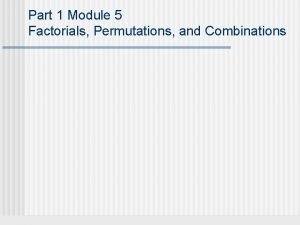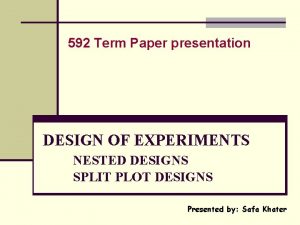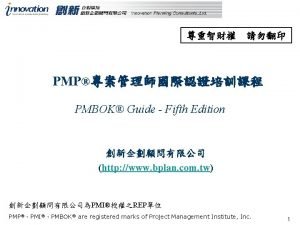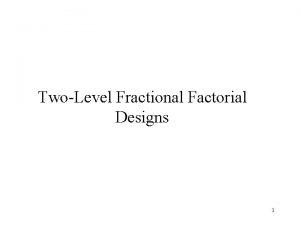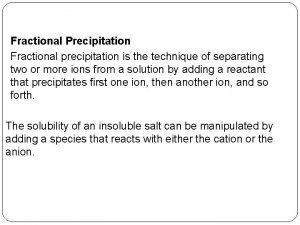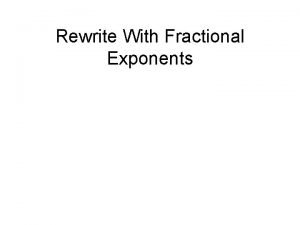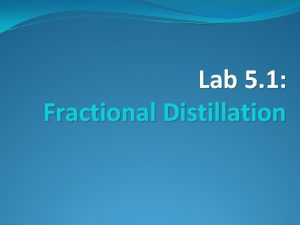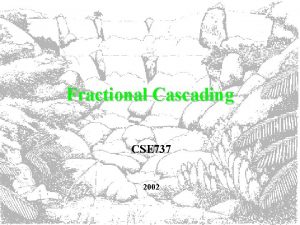Design and Analysis of MultiFactored Experiments Fractional Factorials





![Alias Structure for Factorial Model Intercept = intercept – ABD [A] = A – Alias Structure for Factorial Model Intercept = intercept – ABD [A] = A –](https://slidetodoc.com/presentation_image_h/35e383b42915844a739a204241007ecc/image-6.jpg)
![Alias structure for factorial maineffect model [Intercept] = intercept – 0. 333 CD – Alias structure for factorial maineffect model [Intercept] = intercept – 0. 333 CD –](https://slidetodoc.com/presentation_image_h/35e383b42915844a739a204241007ecc/image-7.jpg)



![ANOVA Analysis of variance table [Partial sum of squares] Sum of Mean F Source ANOVA Analysis of variance table [Partial sum of squares] Sum of Mean F Source](https://slidetodoc.com/presentation_image_h/35e383b42915844a739a204241007ecc/image-11.jpg)




- Slides: 15

Design and Analysis of Multi-Factored Experiments Fractional Factorials Not Based on the Powers of 2 – Irregular Designs L. M. Lye DOE Course 1

Plackett-Burman Designs • The standard two-level designs provide the choice of 4, 8, 16, 32, or more runs, but only to the power of 2. • In 1946, Plackett and Burman invented alternative 2 level designs that are multiples of 4. • The 12 -, 20 -, 24 -, and 28 -run PB designs are particular interest because they fill gaps in the standard designs. • Unfortunately, these designs have very messy alias structures. L. M. Lye DOE Course 2

PB Designs (continued) • For example, the 11 factor in the 12 -run choice, which is very popular, causes the main effect to be aliased with 45 two-factor interactions. • In theory, if you are willing to accept that interactions are zero, you may get away with it. BUT, this is a very dangerous assumption. • Best to stay away from PB designs – better to use standard FFDs or those recently developed Minimum run Resolution V designs. • PB designs are available in Design-Expert but avoid it!. L. M. Lye DOE Course 3

More Irregular Fraction Designs • It is possible to do other “irregular” fractions and still maintain a relatively high resolution. However, these designs are not orthogonal. • An example of this design is the ¾ replication for 4 factors. It can be created by identifying the standard quarter-fraction, and then selecting two more quarter-fractions. i. e. 4 + 4 = 12 runs. • This is a 12 -run resolution V design. See next few pages on the design and alias structure. • These designs were developed by Peter John (1961, 1962, 1971). L. M. Lye DOE Course 4

John’s ¾ Four Factor Screening Design Std A B C D 1 -1 -1 2 1 1 -1 -1 3 -1 -1 4 1 -1 5 -1 1 1 -1 6 1 1 1 -1 7 -1 -1 -1 1 8 1 -1 -1 1 9 -1 1 10 1 1 -1 1 1 12 -1 1 L. M. Lye DOE Course 5
![Alias Structure for Factorial Model Intercept intercept ABD A A Alias Structure for Factorial Model Intercept = intercept – ABD [A] = A –](https://slidetodoc.com/presentation_image_h/35e383b42915844a739a204241007ecc/image-6.jpg)
Alias Structure for Factorial Model Intercept = intercept – ABD [A] = A – ACD [B] = B – BCD [C] = C – ABCD [D] = D – ABCD [AB] = AB – ABCD [AC] = AC –BCD [AD] = AD –BCD [BC] = BC – ACD [BD] = BD – ACD [CD] = CD – ABD [ABC] = ABC -ABD L. M. Lye DOE Course 6
![Alias structure for factorial maineffect model Intercept intercept 0 333 CD Alias structure for factorial maineffect model [Intercept] = intercept – 0. 333 CD –](https://slidetodoc.com/presentation_image_h/35e383b42915844a739a204241007ecc/image-7.jpg)
Alias structure for factorial maineffect model [Intercept] = intercept – 0. 333 CD – 0. 333 ABC + 0. 333 ABD [A] = A – 0. 333 BC – 0. 333 BD – 0. 333 ACD [B] = B – 0. 333 AC – 0. 333 AD - 0. 333 ACD [C] = C – 0. 5 AB [D] = D – 0. 5 AB L. M. Lye DOE Course 7

Warning: Irregular fractions may produce irregularities in effect estimates • Irregular fractions have somewhat peculiar alias structures. E. g. when evaluated for fitting a two-factor interaction model, they exhibit good properties: main effect aliased with three-factor interaction, etc. • But, if you fit only the main effects, they become partially aliased with one or more two-factor interactions. Main effects can get inflated by any large 2 factor interactions. Insignificant main effects may be selected as a result. • Check the p-values in ANOVA for the selected model terms. If there are no interactions, or they are relatively small, then no anomaly. • Normally not a problem because you would never restrict yourself to main effects only. L. M. Lye DOE Course 8

Example: Best set up for using RGB projectors • • • Factors: Low A: Font size 10 pt B: Font Style Arial C: Background Black D: Lighting Off Response: Readability (seconds) High 18 pt Times White On • Readability – time to transcribe a series of random numbers displayed on the screen by a group of students. • We will use a irregular fraction design with 12 runs. L. M. Lye DOE Course 9

Effects Plot L. M. Lye DOE Course 10
![ANOVA Analysis of variance table Partial sum of squares Sum of Mean F Source ANOVA Analysis of variance table [Partial sum of squares] Sum of Mean F Source](https://slidetodoc.com/presentation_image_h/35e383b42915844a739a204241007ecc/image-11.jpg)
ANOVA Analysis of variance table [Partial sum of squares] Sum of Mean F Source Squares DF Square Value Prob > F Model 1501. 58 4 375. 40 60. 64 < 0. 0001 A 1064. 08 171. 89 < 0. 0001 C 266. 67 1 266. 67 43. 08 0. 0003 D 16. 67 1 16. 67 2. 69 0. 1448 AD 168. 75 1 168. 75 27. 26 0. 0012 Residual 43. 33 7 6. 19 Cor Total 1544. 92 11 L. M. Lye DOE Course 11

Results L. M. Lye DOE Course 12

Conclusion • Bigger font – better readability in general • Lights on is better with 18 pt but lights off is better if Font is size 10. • Saved 4 runs by using irregular fraction design. • Design-Expert can construct ¾ fraction when the number of factors is 4, 5, or 6. For 7 factors the fraction is 3/8; for 8 factors the fraction is 3/16; and for 9, 10, and 11 factors the fraction is 1/8, 1/16, and 3/64, respectively. L. M. Lye DOE Course 13

Newer Irregular designs • There also newer minimum run Resolution IV and V designs available in Design-Expert 7. E. g. 6 Factors in 22 runs, 10 factors in 56 runs, etc. These are generated by computer. Alias structure is complicated and the designs are slightly nonorthogonal. • Another approach to obtain irregular fractions is by use of a semi-foldover where only half the number of runs are necessary compared to a full foldover. • E. g. 24 -1 = 8 runs + semi-foldover = 12 runs. • See case study of Hawkins and Lye (2006) • Semi-foldovers can be done using DX-7. L. M. Lye DOE Course 14

Recommendations • Avoid the use of low resolution (Res III) minimum run designs such as Plackett-Burman designs. Unless you can assume all interactions are zero and that time and budget is really tight. • Irregular fraction design can be used with some caution. This is usually not too serious a problem. But check alias structure. • New min run Res V designs can be used to save on runs without compromising too much. L. M. Lye DOE Course 15
 Permutations formula
Permutations formula Torrent qq
Torrent qq 2 kp
2 kp Design of experiments doe
Design of experiments doe Jmp design of experiments
Jmp design of experiments Full factorial design
Full factorial design Design of experiments pmp example
Design of experiments pmp example Paper presentation design
Paper presentation design Orthogonal array
Orthogonal array Pmp stakeholder engagement plan
Pmp stakeholder engagement plan Design of experiments
Design of experiments Six sigma betekenis
Six sigma betekenis Design of experiments
Design of experiments Types of forms in system analysis and design
Types of forms in system analysis and design Introduction to distillation
Introduction to distillation Disadvantages of fractional distillation
Disadvantages of fractional distillation
